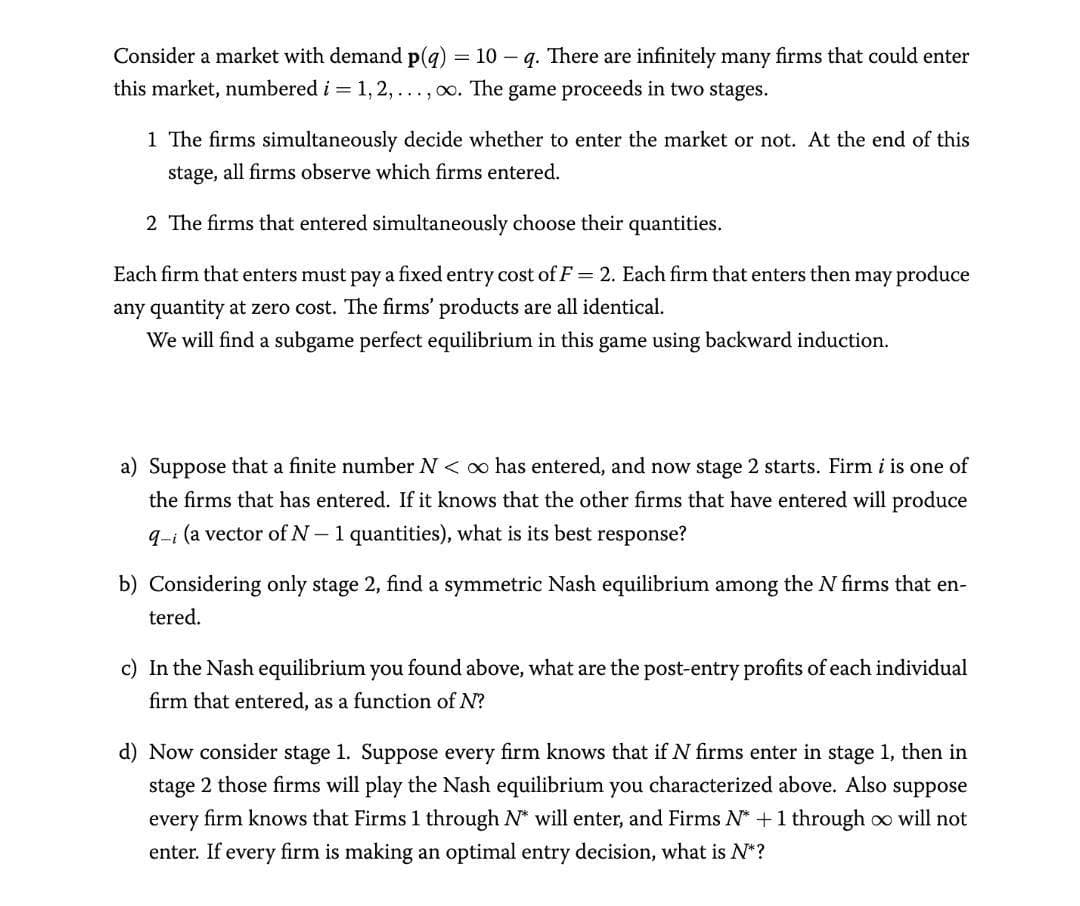Consider a market with demand p(q) = 10 - q. There are infinitely many firms that could enter this market, numbered i = 1, 2,..., o. The game proceeds in two stages. 1 The firms simultaneously decide whether to enter the market or not. At the end of this stage, all firms observe which firms entered. 2 The firms that entered simultaneously choose their quantities. Each firm that enters must pay a fixed entry cost of F = 2. Each firm that enters then may produce any quantity at zero cost. The firms' products are all identical. We will find a subgame perfect equilibrium in this game using backward induction.
Consider a market with demand p(q) = 10 - q. There are infinitely many firms that could enter this market, numbered i = 1, 2,..., o. The game proceeds in two stages. 1 The firms simultaneously decide whether to enter the market or not. At the end of this stage, all firms observe which firms entered. 2 The firms that entered simultaneously choose their quantities. Each firm that enters must pay a fixed entry cost of F = 2. Each firm that enters then may produce any quantity at zero cost. The firms' products are all identical. We will find a subgame perfect equilibrium in this game using backward induction.
Chapter15: Imperfect Competition
Section: Chapter Questions
Problem 15.5P
Related questions
Question
Plz answer a and b

Transcribed Image Text:= 10 – q. There are infinitely many firms that could enter
Consider a market with demand p(g)
this market, numbered i = 1, 2,..., o. The game proceeds in two stages.
1 The firms simultaneously decide whether to enter the market or not. At the end of this
stage, all firms observe which firms entered.
2 The firms that entered simultaneously choose their quantities.
Each firm that enters must pay a fixed entry cost of F = 2. Each firm that enters then may produce
any quantity at zero cost. The firms' products are all identical.
We will find a subgame perfect equilibrium in this game using backward induction.
a) Suppose that a finite number N< o has entered, and now stage 2 starts. Firm i is one of
the firms that has entered. If it knows that the other firms that have entered will produce
q-i (a vector of N-1 quantities), what is its best response?
b) Considering only stage 2, find a symmetric Nash equilibrium among the N firms that en-
tered.
c) In the Nash equilibrium you found above, what are the post-entry profits of each individual
firm that entered, as a function of N?
d) Now consider stage 1. Suppose every firm knows that if N firms enter in stage 1, then in
stage 2 those firms will play the Nash equilibrium you characterized above. Also suppose
every firm knows that Firms 1 through N* will enter, and Firms N* +1 through oo will not
enter. If every firm is making an optimal entry decision, what is N*?
Expert Solution
This question has been solved!
Explore an expertly crafted, step-by-step solution for a thorough understanding of key concepts.
This is a popular solution!
Trending now
This is a popular solution!
Step by step
Solved in 2 steps

Knowledge Booster
Learn more about
Need a deep-dive on the concept behind this application? Look no further. Learn more about this topic, economics and related others by exploring similar questions and additional content below.Recommended textbooks for you


Principles of Microeconomics (MindTap Course List)
Economics
ISBN:
9781305971493
Author:
N. Gregory Mankiw
Publisher:
Cengage Learning

Managerial Economics: A Problem Solving Approach
Economics
ISBN:
9781337106665
Author:
Luke M. Froeb, Brian T. McCann, Michael R. Ward, Mike Shor
Publisher:
Cengage Learning


Principles of Microeconomics (MindTap Course List)
Economics
ISBN:
9781305971493
Author:
N. Gregory Mankiw
Publisher:
Cengage Learning

Managerial Economics: A Problem Solving Approach
Economics
ISBN:
9781337106665
Author:
Luke M. Froeb, Brian T. McCann, Michael R. Ward, Mike Shor
Publisher:
Cengage Learning

Exploring Economics
Economics
ISBN:
9781544336329
Author:
Robert L. Sexton
Publisher:
SAGE Publications, Inc

Microeconomics: Principles & Policy
Economics
ISBN:
9781337794992
Author:
William J. Baumol, Alan S. Blinder, John L. Solow
Publisher:
Cengage Learning